2005 VOLKSWAGEN GOLF belt
[x] Cancel search: beltPage 93 of 444
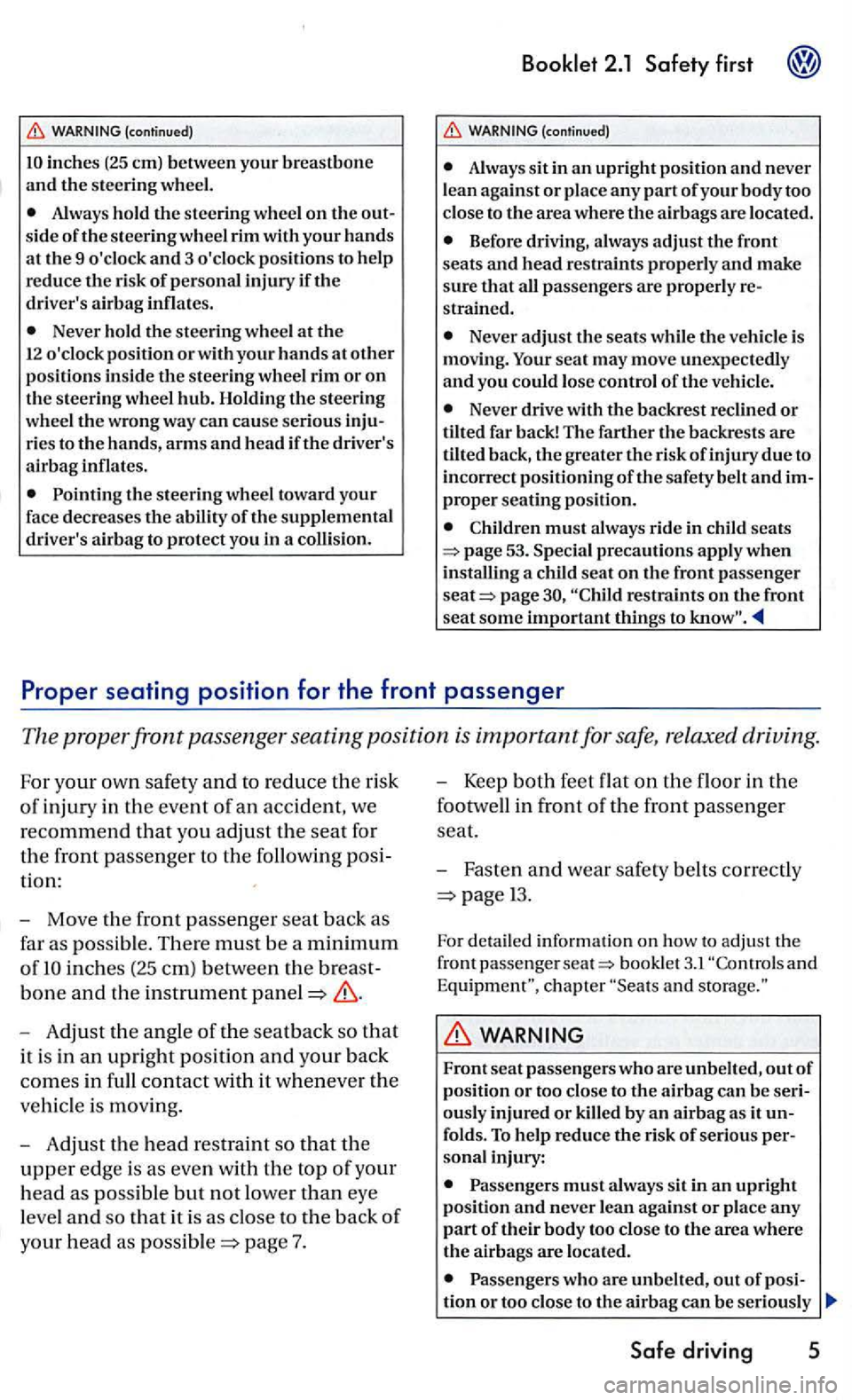
inches (25 em) between your breastbone and the steering wheel.
Always hold the s teering wheel on the
Never hold the steering wheel at the 12 o'clock position or with your hands at other positions inside the steering wheel rim or on the steering wheel hub. Holding the steering
wheel the wrong way can cause serious
2.1 Safety first
(continued)
Always sit in an upright posit i on and never lean against or place any part of your body too
close to the area where the airbags are located.
strained.
Never adjust the seats the vehicl e is mov ing. Your seat may move unexpecte dly and yo u could lose control of the vehicle.
Never drive wit11 the backrest reclined or tilted far back! The fart her t11e backrests are tilted back, the greater the risk of injury due to
incorrect positionin g ofthe safety belt and
Children must always ride in child seats
page restraints on t11e front seat some important things to
Move the front passenger seat back as
far as possible. There must be a minimum
of
Adjust th e angle of the seat back so that
it is in an upright position and your back
comes in full contact with it whenever the
veh icle is moving.
Adjust the head restra int so that the
upper edge is as eve n with the top of your
h
ead as poss ible but not lower than eye
leve l
and so that it is as close to the back of
your head as
Keep both feet flat on the floor in the
footwell in fron t
of the front passenger
seat.
Fasten and wea r safety belt s co rrectly
13.
For detail ed inform ation on how to adju st the
front passenger bookl et 3.1 and s torage.""
WARNING
Front seat passengers who are unbelted, out of posit ion or too close to the airbag can be
risk of serious
Passengers must always sit in an upright position and nev er lean against or place any part of their body too clos e to the area where the airbags are located.
Passengers who are u nbelted, out
Safe driving 5
Page 94 of 444
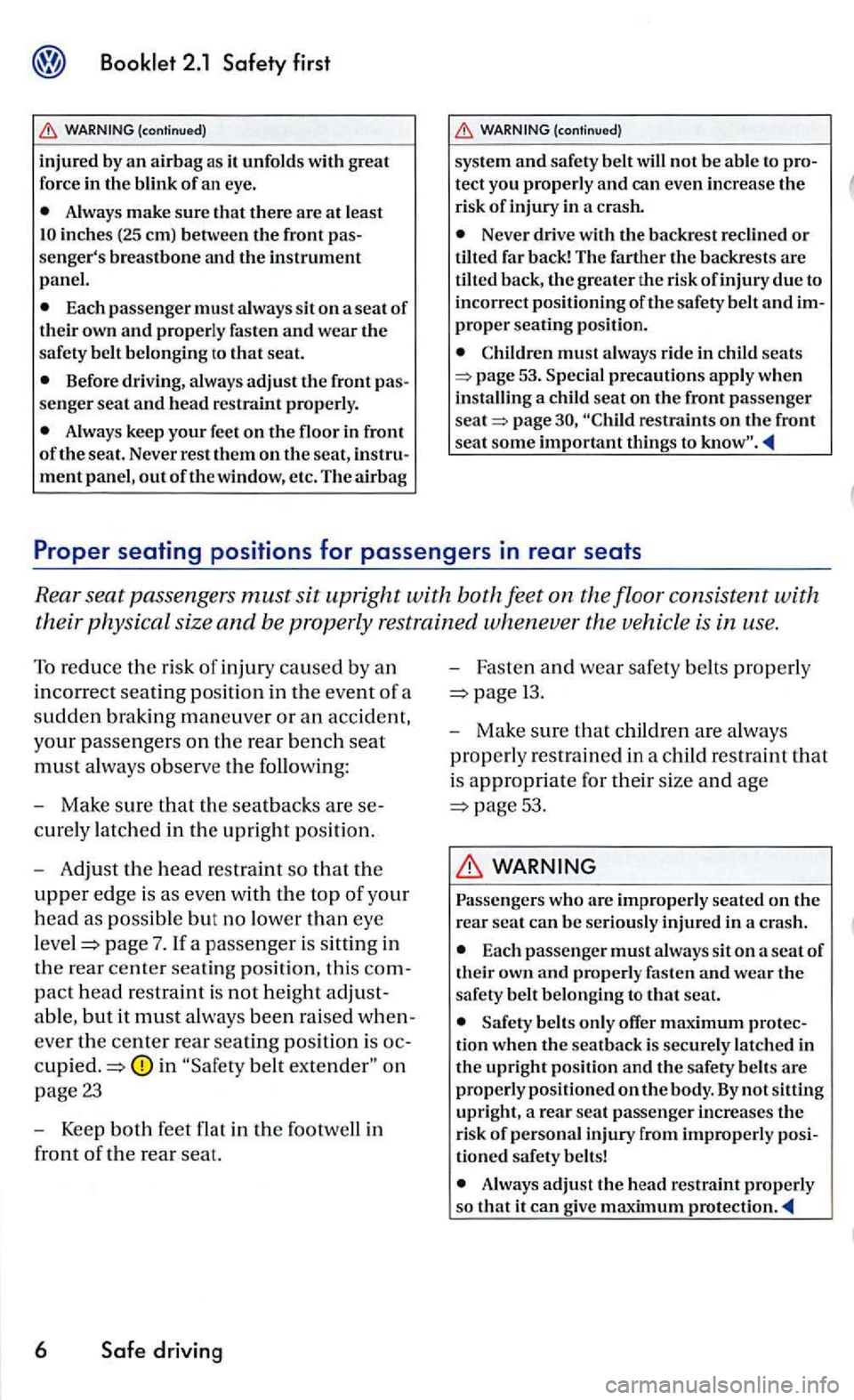
Always make sure that there are at least
Each passenger must always sit on a seat of their own and properly fasten and wear the safety belt be longing to that seat.
Before driving , always adjust the front senger seat and head re straint properly.
Alway s keep your feet on the floor in front of the seat. Never rest them on the seat, ment panel, out of the window, etc. The airbag
tect you properly and can even increa se th e
risk of injury in a crash.
Neve r drive with the backre st recl ined or tilted far back! The farth er the b ackrests are
tilted back, the greater the risk ofinjury due to
in correct positioning of the safety belt and
must always ride in seats 53. a child seat on the front passenger page
Mak e sure that the seatback s are
curel y lat ch ed in the upright position.
A djust th e head restraint so that the
upper edge is as even with the top of your
head as possible but no lower than eye
pag e 7. If a passe nger is s ittin g in
the rear center seating pos ition, this
pac t h ead restra int is not h eight
a ble , but it must always bee n rais ed
eve r the center rear seating posit ion is
belt on
page 23
Keep both feet flat in the footwell in
front
of the rear seat.
6 Safe driving
Fasten and wear safe ty belt s properly
13.
Make sure that children are always
prop e
rly restra in ed in a child re str aint that
is appropriate for thei r size and age
5 3 .
WARNING
Pas sengers who are improperly seated on the rear seat can be se riou sly injure d in a crash.
Each passen ge r must always sit on a seat of th eir own and properly fasten and wear the safety belt belonging to that seat.
belt s only offer maximum tion when the seat back is securely latched in
th e upright po siti on and the safety belts are
properly positioned on the body. By not sitting
upright , a re ar seat pass enger increases the risk of personal injury from improperl y
Always adjust the head restraint properly so that it can give maximum
Page 101 of 444
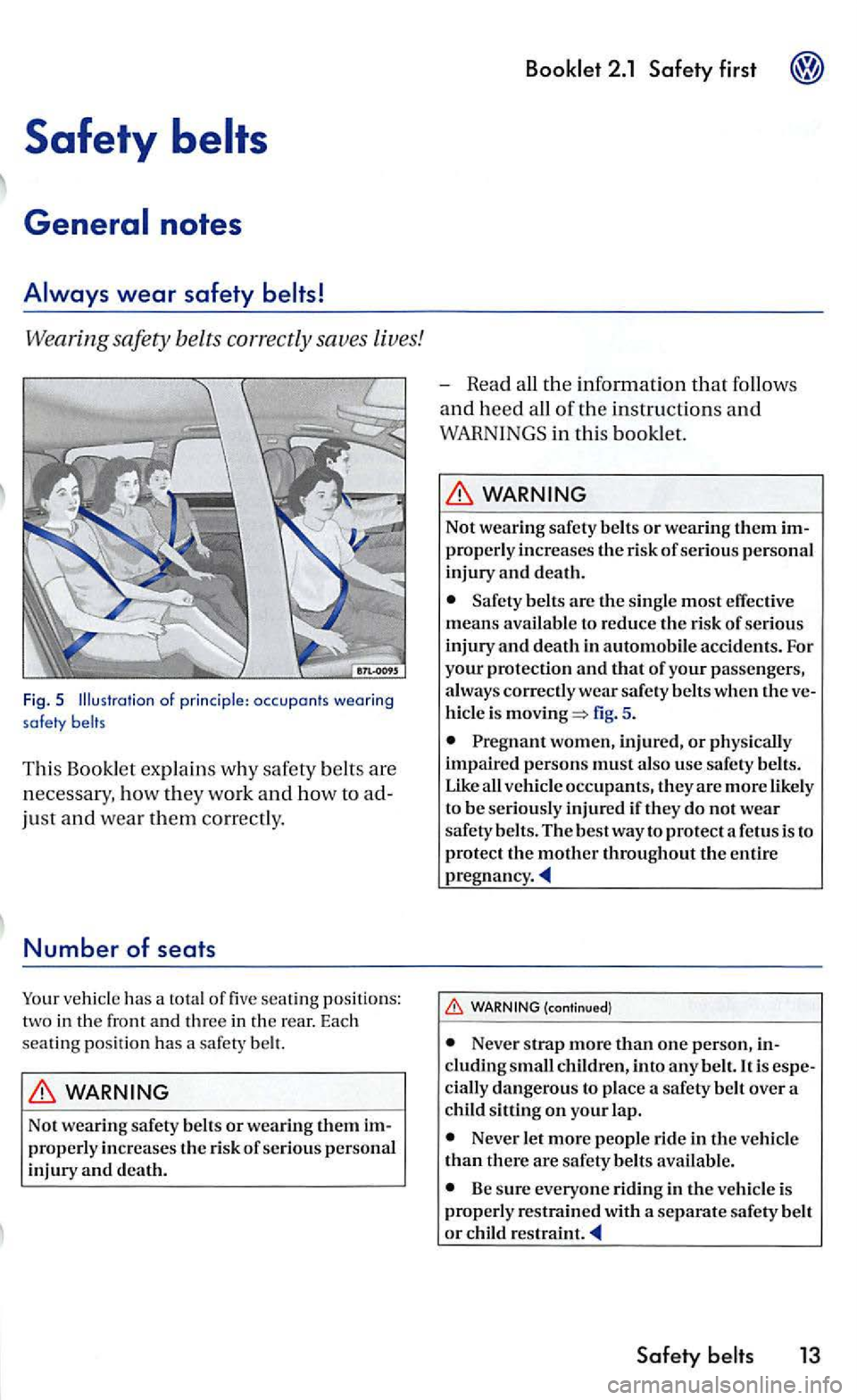
Safety
wear safety
Wearing safety belts correctly saves lives!
Fig. 5 of principle: occu pants wearing safety belts
This Booklet expla in s w hy safety belt s are
necessa ry . how they work and how to
just and wear them correctly .
Number of seats
Your vehicl e has a total of five se ating position s:
two in t h e fron t and three in th e re ar. Eac h seating positio n has a sa fe ty belt.
WARNING
Not wearin g safety belts or wea ring them
- Read all the information that follows
and heed all of the instructio ns and
WARNINGS in thi s bookl et.
WARNING
No t wearing safety belt s o r wearing them properly increases the ris k of se rious pe rson al
injury and death.
Safety belts are th e s ingle most effective
means availa ble to reduce the risk of serious inju ry and death in automobile acciden ts . For your protection and that of your passengers,
a lways correctl y wear safety belts when the hicle is fig. 5 .
Pregnant women, injured, or physically
i mpaired person s must also use safety belts.
Like vehicl e occ upants, th ey are more like ly
to be se riously injured if th ey do not wear safety belts. The best way to protect a fetus is to protec t the mother throughout the entire
pregnancy
(continued !
Never strap more than one person, cluding cially dangerous to plac e a safety belt over a child sittin g on your lap.
Neve r let more people ride in the ve hicle than there are safety belts available.
B e sure everyo ne ridin g in the vehicl e is properl y res trained with a separate sa fety belt
o r chil d res train t
Safety
Page 102 of 444
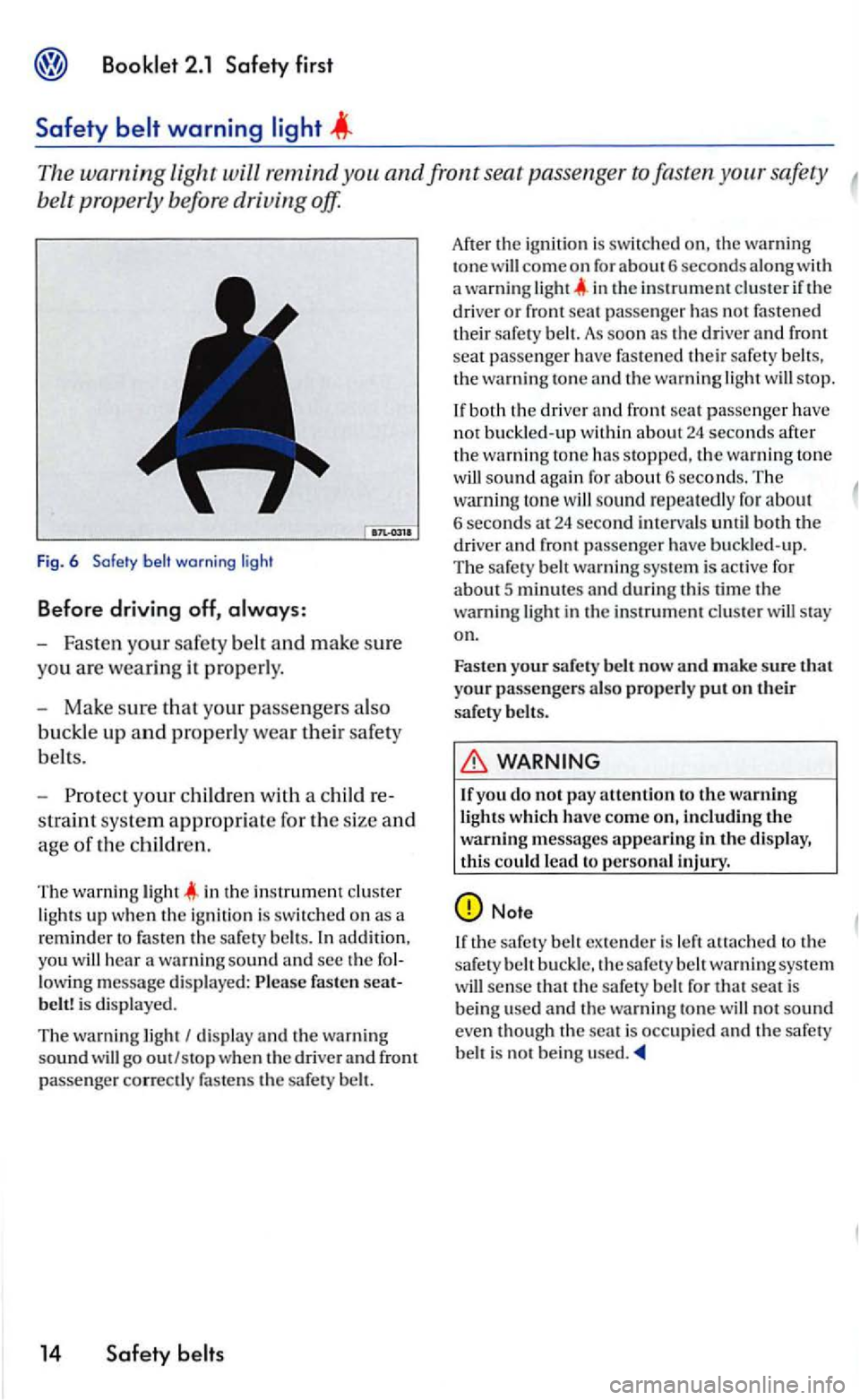
The warning Light will remind safety
belt prop erly before driving off.
Fig . 6 Safety warn in g l ig ht
Before driving off,
-Fast en your safety belt and make sure
you are wea ring it properly.
- Mak e sure that your passengers als o
buckle
up and properly wear their safety
b elts.
- Pro tec t yo
ur children with a child re
s traint sys
tem appropria te for the size and
age of th e children.
T he wa rnin g in the in strument lights up w he n the ig niti on is switched o n as a
reminder to fasten th e safety addition,
yo u
14 Safety
Afte r the ig nition is swit ch ed th e warning tone come on for about6 second s along with warning light in the in strument if th e drive r or front seat passe nge r has not fastened their safet y bel t. As soon as the driver and front seat passe nger have fastened their safety the wa rnin g ton e and the warning light stop .
sound aga in for about 6 second s. The
ton e w ill sound repeatedly for about 6 seconds 24 second interva ls until both drive r and front passenger have buckled-up .
T he safety wa rnin g system is active for about 5 minutes and during thi s time the warni ng light in the instrument clus te r wiU stay
on.
Fa s
ten your safe ty belt now and make sure t hat your passengers also properly put o n their
safery belts.
WARNING
If yo u do not pay attenti on to the warning
li ghts whic h h ave come including the warning messages appearing in the display, this could lead to pe rsonal injury.
ex tender is left attac h ed to the
s afery warning sys tem will sense th at th e safe ty n o t sound even though th e is occ upie d and the safery
Page 103 of 444
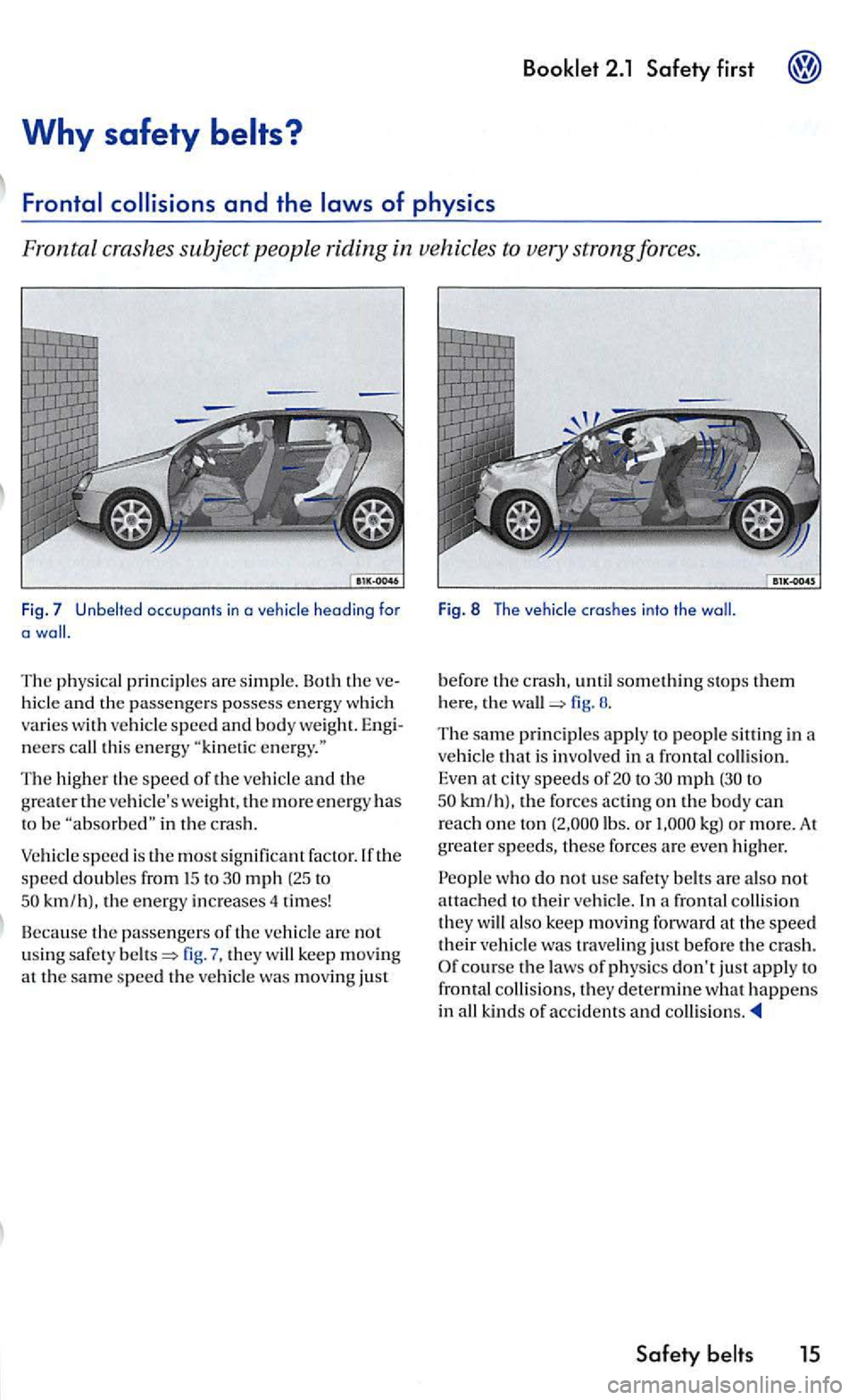
first
Why safety belts?
occupants in a
The physical prin ciples are simpl e. Both the
neers call this energy
The higher the speed of the vehicle and the grea te r th e vehicle's weight, th e more energy has to be in th e crash.
Vehicle spee d is the most s ignificant factor.lfthe speed doubles from 15 to mph (25 to km /hJ. the energy inc reases 4 times!
Because the passengers of th e veh icle are no t
using safety fig . th ey will keep moving at th e sa m e speed the ve hicl e was moving just
Fig . 8 The vehicle crashes into th e
before th e until something stops them th e wall fig. 8.
The same principles ap ply to people s itting in a
ve hicle that is in volved in a fron ta l collis io n.
Even at mph th e fo rces acting on th e body can reach one ton kg) or more. A t
greater
course the laws of phys ics don 't just apply to
frontal collisions, they determine what happens in all kinds of accidents and collisions.
Page 104 of 444
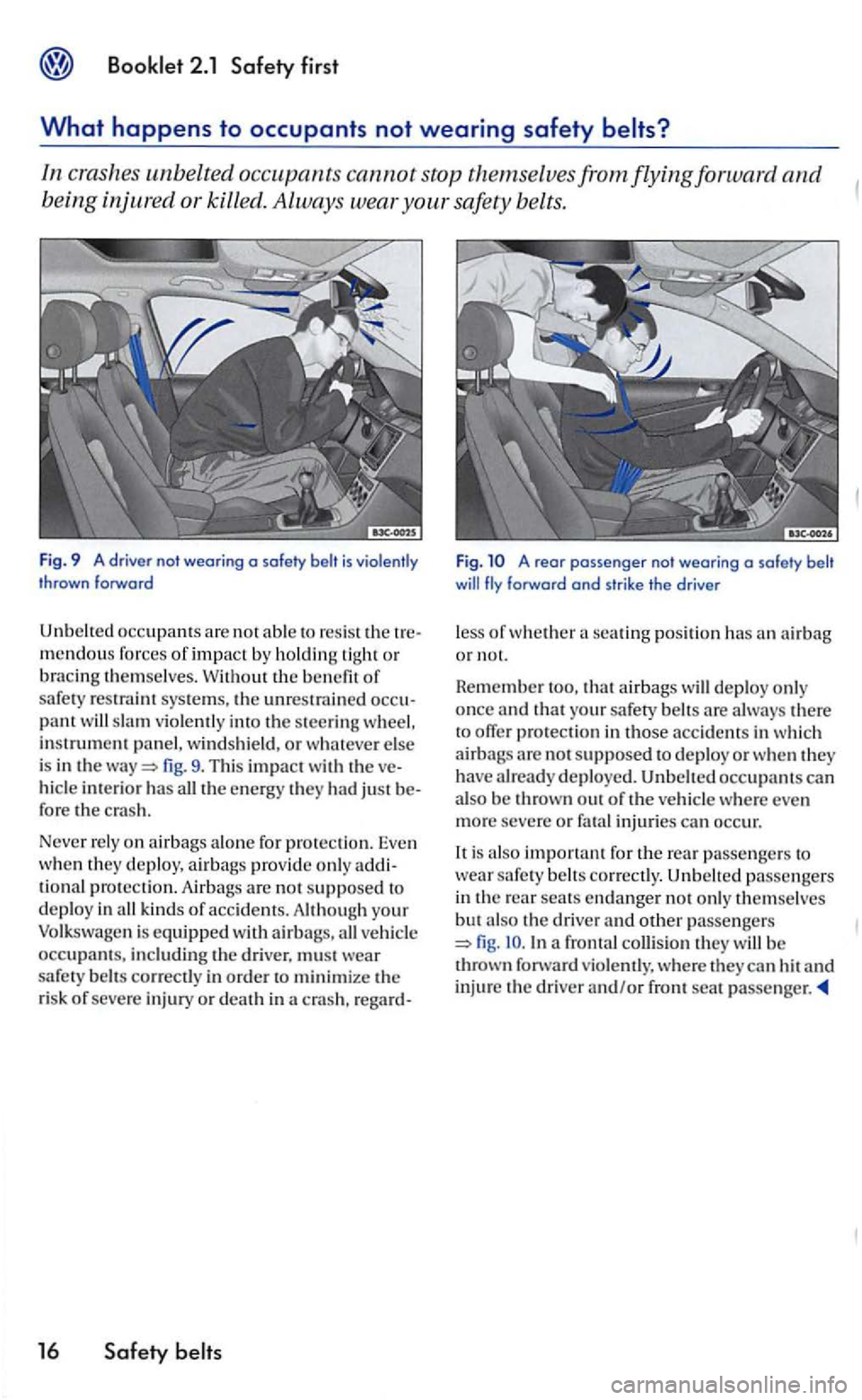
In crashes unbelted occupants cannot stop themse lvesfromflyingforward and
b eing injured or killed. Always wear safety belts.
Fig . 9 A driver not wearing o safety belt is violen tly
t hrown forward
mend ous forces of impact by holdin g tight or b racing themselves. Witho ut the benefit of
safe ty res traint systems, the unre strain ed pant will sla m vio le ntl y into the steering wheel.
instrument pan el, win dshield , or whateve r else
is in the fig . 9 . T his impact with the hi cle int erio r has all the energ y they had ju st
tional pro tection. Airb ags are no t supposed to
deploy in all kinds of ac cid en ts. your Volkswa gen i s equipp ed with airb ags. all vehicle occupams, inclu ding th e driver. must sa fe ty correctly in order to m in imize the risk of severe inj ury or d ea th in a crash , regard-
16 Safety
Fig. A rear passenger not wearing a safety belt fly forward and strike the driver
less of w hether a seating p os ition has an ai rbag
occupants can al so be thro wn out of the vehicle whe re even more severe or fatal injuries can occur.
is also important f or the rea r passe nge rs to
wear safet y
I n a fronta l collision they will be thrown forward violemly, where they can hit and inju re th e driv er and/or fro nt seat passe nger.
Page 105 of 444
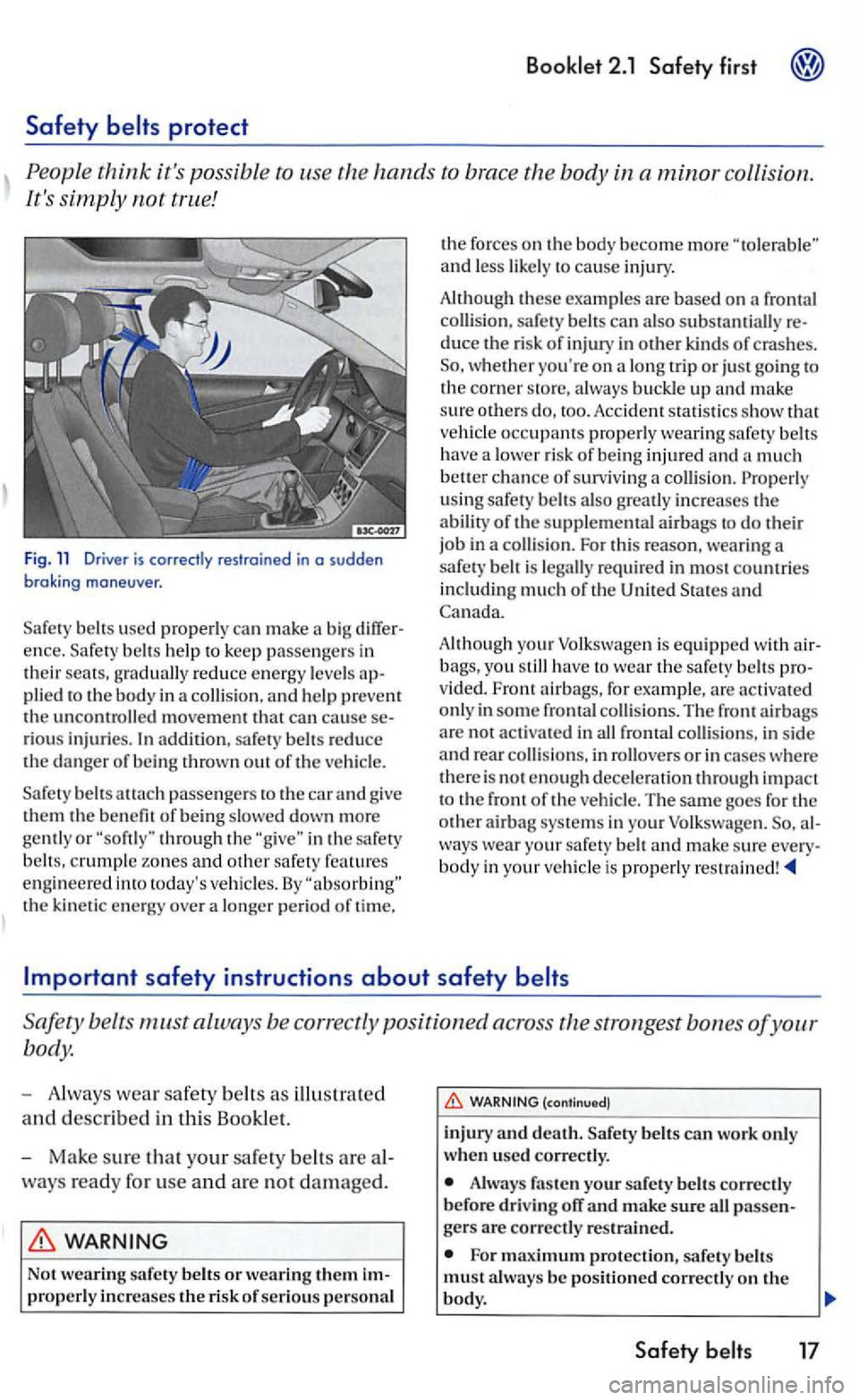
Booklet 2.1 Safety first
Safety
Fig . 11 Driver is correctly restrained in a sudden braking maneu ve r.
used properly can make a big differ
e n ce . help to kee p passenge rs in
t h ei r gradually red uce energy levels applied to the body in a collisio n. an d h elp prevent
t h e uncontrolled movement that can cause se
r ious injuries. additio n, safety reduce the danger of being throw n out of the vehicle.
passengers to the car and give them the benefi t o f being slowed down more ge ntly or t hroug h the c rumple zones and oth er sa fety features engineered today's vehicles. By
hough these examples are based on
Acci dent statist ics show that
veh icle occupants prop erly wearing safety have a lowe r risk of being i n ju red and
pro
v id ed . Fron t airbags, for example, are activated
only in some frontal collisions. The front airbags
are not activated in all frontal collision s, in side and rea r collisions, in rollovers or in cases where
there is not e n ough deceleration through impact
to the front of the ve hicle. The sa me goes for the
o ther airbag systems in your Volk sw age n. al
ways wear your saf ety
safety instructions about safety
Safety belts must always be correctly positioned across
Always wear safety belts as illu strate d
a
nd d esc ribed in thi s Book let.
WARNING
Not wearing safety belt s or w earin g them im
p ro perl y in cre ases the ri sk of serio us pe rso nal
Always fas te n your safety belt s correc tly
before driv ing off and make su re all passen gers are corr ec tly res traine d.
For m aximum protectio n, safe ty belts must a lways be pos itioned correctly on the
Safety belts 17
Page 106 of 444

2.1 Safety first
Never strap more than one person, in
cluding c hildren, into any belt.
Never place a safety belt over a child sittin g on your lap.
• Always keep feet in
the footwell in front of the seat while the vehicle is being driven.
Never let any person ride with feet on the instrument panel or sticking out the window or on the seat.
Never remove a safety belt while the ve
hicle is moving. Doing so will increase your
risk of being injured or killed.
Never wear belt s twisted.
Never wear belt s over rigid or breakable
objects in or on your clothing, such as eye
glasses, pens, keys, etc., as these may cause injury.
Never allow safety belts to become damaged by being caught in door or seat hardware.
Never wear the shoulder part of the belt under your arm or othenvise out of position.
Several layers of heavy clothing may inter
fere with correc t positioni11g of belts and reduce the overall effectiveness of the sys tem.
18 Safety
(continu ed)
Always keep belt buckles free of anything
that may preven t the buckle from latch ing se
cure ly.
Neve r use comfort clips or devices that create slack in the sh oulder belt. However,
specia l clips may be required for the correct
use of some c hild restraint systems.
Torn or frayed safety belts can tear and damaged belt hardware can break in an accident.lnspect belts regularly. If webbing, bind
ings, buckles, or retractors are damaged, have
be lts replaced by an authorized Volkswagen
dealer or qualified workshop.
Safety belts that have been worn and loaded in an accident must be replaced with the correc t rep lacement safety belt by an authorized Volkswagen dealer or qualified work
s h op. Replacement may be necessary even if damage cannot be clearly seen. Anchorag es
that were loaded must a lso be inspected.
Never remove, modify, disassem ble, or try
to repair the safety belts yourself.
Alwa ys keep the belts clean. Dirty belts
may not work correct ly and can impair t11e func tion of inertia reel booklet 3.2 and